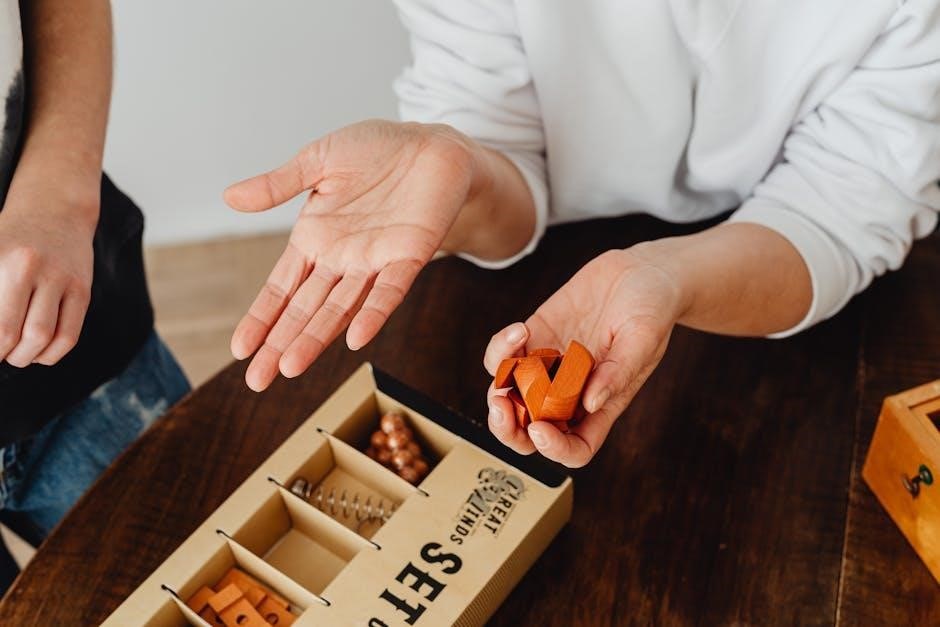Shut the Box is a classic, engaging dice game that combines strategy and math, offering fun for all ages while fostering mental sharpness and competitive spirit.
Overview of the Game
Shut the Box is a classic, easy-to-learn dice game that combines luck and strategy. Played on a wooden board with numbered tiles, players aim to “shut” or flip down tiles by matching dice sums. The game begins with all tiles upright, and players take turns rolling two dice. The sum of the dice determines which tiles can be flipped. For example, a dice roll of 3 and 4 (sum of 7) allows flipping tiles that add up to 7. The goal is to minimize remaining tiles, with the lowest score winning. Shut the Box is simple yet strategically rich, making it a favorite for both casual and competitive play.
Objective of the Game
The primary objective of Shut the Box is to flip down all the numbered tiles on the game board by matching the sum of rolled dice. Players take turns rolling two dice, and the sum determines which tiles can be lowered. The goal is to strategically choose tiles that add up to the dice total, aiming to minimize the number of remaining tiles. If a player successfully shuts all tiles, they win immediately. If not, the game ends when no more valid moves are possible, and the player with the lowest sum of remaining tiles is declared the winner. Mastery requires a blend of luck and strategic thinking.
Why Play Shut the Box?
Shut the Box is an excellent choice for those seeking a game that combines fun with mental stimulation. It enhances mathematical skills, particularly in addition and strategic planning. The game is simple to learn, making it accessible to all ages, yet challenging enough to keep experienced players engaged. It fosters healthy competition and can be played individually or in groups, promoting social interaction. Additionally, it’s portable and easy to set up, making it ideal for travel or casual gatherings. Playing Shut the Box not only entertains but also sharpens cognitive abilities, making it a rewarding activity for both children and adults alike. Its versatility ensures lasting enjoyment for everyone involved.

Materials Needed to Play
A wooden game board, numbered tiles (typically 1-12), two dice, and a lid or flap system to “shut the box” are essential for gameplay.
The Game Board
The game board is the central component of Shut the Box, typically made of wood and featuring numbered tiles (1-12) arranged in a horizontal line.
It includes a hinged lid or flap system that allows players to “shut” the tiles by flipping them down. The board’s design ensures tiles stay secure
when flipped, and some versions include a built-in dice-rolling area for convenience. Compact and portable, the board is designed for easy setup
and storage, making it ideal for travel or home use. The board’s layout and mechanics are key to the game’s functionality and fun,
providing a clear, organized space for players to strategize and compete.
The Dice
The game requires two standard six-sided dice, each numbered from 1 to 6, which are used to determine the sum for flipping tiles.
Dice are typically made of plastic or wood, matching the game’s aesthetic. Players roll both dice on the board to calculate their total,
which dictates which numbered tiles can be flipped down. The dice are essential for initiating each turn and driving the game’s progression.
Their randomness adds an element of unpredictability, making each turn exciting and challenging. Proper use of the dice is crucial for fair play,
and they are rolled on a flat surface, often within the board’s designated area for convenience. The dice are simple yet vital tools,
central to the game’s mechanics and enjoyment.
Numbered Tiles
The numbered tiles are a crucial component of the game, typically ranging from 1 to 9 or 1 to 12. These tiles are arranged on the game board and must be flipped down strategically based on the sum of the dice rolls. Each tile represents a number that players aim to eliminate by achieving the corresponding total with the dice. The tiles are usually made of wood or another durable material and are an integral part of the game’s design. Players can choose to flip a single tile matching the dice sum or multiple tiles that add up to the total. The goal is to minimize the number of remaining tiles, as these contribute to the final score. Successfully flipping all tiles results in an instant win, making them central to both gameplay and victory.
Other Components
Beyond the game board, dice, and numbered tiles, additional components may include a scorepad for tracking points, an instruction manual for learning the rules, and accessories like a dice cup for rolling. Some versions feature a built-in storage compartment to keep all pieces organized. Optional components might include alternative tile sets for variations or themed designs. These extras enhance the gameplay experience, ensuring everything needed is conveniently at hand. The scorepad is crucial for tallying remaining tiles, determining the winner, and comparing scores across multiple games. Instructions provide clarity for setup and rules, making the game accessible to new players. Accessories like dice cups add convenience, while optional features offer customization and variety.
Setting Up the Game
Setting up involves arranging the game board, positioning all numbered tiles upright, ensuring all components are ready, and organizing the playing area for smooth gameplay.
Preparing the Board
Start by placing the game board on a flat, stable surface. Ensure all numbered tiles are correctly aligned and in their designated slots. Each tile should be upright and visible. The board typically features a row of numbered tiles, often ranging from 1 to 9 or 1 to 12, depending on the version. Verify that no tiles are already flipped down before beginning. If the board has a lid or cover, open it to expose the tiles. Ensure all components, such as dice and tiles, are securely in place. This setup ensures the game is ready for players to start rolling the dice and flipping tiles according to the rules.
Positioning the Tiles
The numbered tiles are placed in a specific arrangement on the game board, typically in a single row. Each tile is positioned to face upward, ensuring they are fully visible and accessible. The tiles are usually numbered from 1 to 12, depending on the version of the game. Ensure each tile is securely placed in its designated slot to avoid movement during gameplay. The board’s design often features a built-in tray or track to keep the tiles organized and aligned. Proper positioning ensures that players can easily identify and flip the correct tiles based on dice rolls. Double-check that all tiles are correctly placed before starting the game to avoid any discrepancies.
Initial Player Setup
Before the game begins, ensure each player has a clear view of the game board. Players should gather around the board, ideally seated comfortably to access the dice and tiles easily. The tiles are initially placed face-up, and the board is fully opened to reveal all numbered slots. Each player starts with all tiles upright, ready to be flipped as the game progresses. The dice are placed in the designated rolling area, and players should agree on the starting player, often determined by a random dice roll. Ensure all players understand the rules and objectives to avoid confusion during gameplay. Proper player positioning and readiness are crucial for a smooth start.

Basic Rules of Play
Players roll dice, calculate the sum, and flip corresponding numbered tiles; Turns alternate, with each player aiming to lower tiles strategically to achieve the game’s objective efficiently.
Rolling the Dice
Rolling the dice is the cornerstone of the game, initiating each player’s turn. Players roll two standard six-sided dice onto the board. The sum of the dice determines which tiles can be flipped. For example, a roll of 3 and 4 results in a sum of 7, allowing the player to flip tiles that add up to 7. The dice roll sets the stage for strategic tile selection, as players aim to lower tiles effectively. Each roll must be performed on the open area of the board, ensuring visibility and fairness. The dice roll is the starting point for every turn, driving the game’s progression and player decisions.
Calculating the Sum
After rolling the dice, the next step is to calculate their sum. This total determines which numbered tiles can be flipped. For instance, rolling a 3 and a 5 results in a sum of 8, allowing players to flip tiles that add up to 8. The sum can be achieved in multiple ways, such as flipping the 8 tile directly or combining smaller tiles (e.g., 5 and 3). Accurate calculation is crucial, as invalid moves are not permitted. This step combines basic math skills with strategic thinking, making it both educational and engaging. Proper calculation ensures players make valid moves, advancing their progress in the game effectively.
Flipping Tiles
After calculating the sum of the rolled dice, players must flip tiles that match the total. For example, if the dice show a 4 and a 3 (sum of 7), the player can flip the 7 tile or any combination of tiles (e.g., 5 and 2, or 6 and 1) that add up to 7. Only tiles with numbers equal to or greater than the dice sum can be flipped. Once a tile is flipped, it cannot be flipped back. The goal is to flip as many tiles as possible to minimize the number of remaining tiles. This step requires strategic thinking to maximize progress and improve chances of winning the game.
Turn-Based Gameplay
Players take turns rolling the dice, with each turn beginning with a roll and ending when no more valid moves can be made. On a player’s turn, they roll the dice and calculate the sum. Using this sum, they flip tiles that match the total or a combination of numbers that add up to it. If a player cannot flip any tiles with the rolled sum, their turn ends. The game progresses clockwise, with each player taking their turn independently. The objective remains consistent: to minimize remaining tiles or achieve a complete shut. Each turn is a fresh opportunity to strategize and reduce the number of tiles, bringing the player closer to victory;
Advanced Strategies
Optimize tile selection by prioritizing higher numbers first, minimizing leftover tiles strategically. Use mathematical insights to maximize chances of closing all tiles efficiently and winning the game.
Optimizing Tile Selection
Optimizing tile selection is crucial for improving your chances of winning. Focus on closing higher-numbered tiles first, as they are harder to achieve with dice rolls. By strategically choosing which tiles to flip, you can minimize the number of remaining tiles and reduce complexity in later turns. Consider the sum of the dice and how it can cover multiple tiles, maximizing efficiency. Additionally, think ahead to future rolls, ensuring your choices leave flexibility for closing remaining tiles. This approach requires mathematical insight and foresight, making it a key advanced strategy for mastering the game. It also helps avoid leaving behind tiles that are difficult to close later, increasing your overall efficiency and likelihood of success.
Minimizing Remaining Tiles
Minimizing remaining tiles is a strategic goal in Shut the Box, as fewer tiles left at the end result in a lower score. To achieve this, players should prioritize closing tiles that are less likely to be closed in future rolls, such as higher numbers or those requiring specific combinations; By systematically reducing the number of tiles, you create fewer opportunities for opponents to score and increase your chances of shutting the box entirely. Balancing immediate tile closures with long-term flexibility is key, ensuring that each move brings you closer to the goal. This approach not only enhances your gameplay but also demonstrates a mastery of the game’s dynamics and potential outcomes.
Mathematical Approach
A mathematical approach in Shut the Box involves leveraging probability and strategic planning to maximize tile closures. Players can optimize their moves by focusing on dice sums that offer multiple tile-closing opportunities. For example, targeting numbers like 6 or 7, which have higher probabilities of occurring, increases the likelihood of closing tiles. Additionally, calculating the remaining tiles and predicting future dice combinations allows for informed decisions. This method ensures efficient use of each roll, minimizing leftover tiles and enhancing overall performance. By adopting a mathematical mindset, players can transform the game into a strategic challenge, blending luck with calculated precision to achieve success.

Scoring and Winning
Scoring is based on the sum of remaining tiles. The player with the lowest total wins. Closing all tiles results in an instant victory.
Scoring System
The scoring system in Shut the Box is straightforward. At the end of the game, players add up the numbers on any remaining unflipped tiles. The player with the lowest total score wins. If a player successfully flips all the tiles, they automatically win, as this is considered “shutting the box.” Each turn, the goal is to minimize the sum of the remaining tiles by strategically flipping them based on the dice rolls. The game encourages players to aim for the lowest possible score, making every decision count toward achieving victory.
Winning Conditions
Winning in Shut the Box is achieved when a player successfully flips all the numbered tiles, thereby “shutting the box.” This can happen during a player’s turn if they roll the necessary dice sums to flip the remaining tiles. If multiple players are close, the game continues until only one player achieves this goal. Additionally, if no player can flip all tiles, the player with the lowest sum of remaining tiles at the end of the game is declared the winner. The objective is to eliminate all tiles or have the smallest possible total left, making each roll crucial in determining the outcome. The game rewards both skill and luck, ensuring exciting gameplay every time.
Special Cases
In Shut the Box, special cases arise when a player cannot use the dice sum to flip any remaining tiles, resulting in a loss of turn. If a player flips a tile that was already shut, it is typically considered an invalid move, and they must revert the change. Additionally, if all tiles are shut except for one, the player must roll a sum that exactly matches the remaining tile’s number to win. If the final tile cannot be shut, the game continues with other players until all possibilities are exhausted. These special scenarios add layers of complexity and strategy to the game, ensuring dynamic and unpredictable gameplay experiences. Proper handling of these cases is essential for maintaining fair play and excitement.

Variations of the Game
Shut the Box offers diverse variations, including different tile ranges, alternative winning conditions, and team play options, ensuring fresh and exciting gameplay experiences for all players.
Different Tile Ranges
Shut the Box can be played with varying ranges of numbered tiles, such as 1-9, 1-12, or even higher, depending on the version. This flexibility allows players to adjust the game’s difficulty and complexity. For example, a 1-12 range increases the challenge, as it requires covering more numbers, while a 1-9 range simplifies the game for younger players or beginners. Some variations also include additional tiles with special symbols or rules, adding a unique twist to the gameplay. This adaptability ensures the game remains engaging for a wide range of skill levels and preferences, making it suitable for both casual and competitive play.
Alternative Winning Conditions
Shut the Box offers flexibility with alternative winning conditions to enhance gameplay. In some versions, players aim to achieve the lowest possible score by minimizing the sum of remaining tiles. Others may set a target number, where closing specific tiles adds up to that target. Additionally, some variations introduce a “shutdown” rule, where closing all tiles instantly wins the game. These alternative conditions add variety and challenge, allowing players to experiment with different strategies. They also make the game more inclusive, as players can choose rules that suit their skill levels or preferences, ensuring fun and engagement for everyone involved.
Team Play Options
Shut the Box can be enjoyed in team play, adding a collaborative twist to the classic game. Teams divide players into groups, sharing turns and strategies to minimize remaining tiles. Each team member takes turns rolling the dice, contributing to the collective goal of closing tiles. Scores are combined, and the team with the lowest total wins. This format fosters teamwork and communication, making it ideal for social gatherings or group events. Team play also allows for larger groups to participate, enhancing the game’s accessibility and fun factor while maintaining its core mathematical and strategic elements. It’s a great way to engage multiple players and create a lively atmosphere. Teams can even compete against each other, adding a competitive edge to the gameplay experience.
Shut the Box is a simple yet strategic game ideal for casual or competitive play, offering endless fun for players of all ages and skill levels.
Final Tips
To master Shut the Box, practice mental math to quickly calculate dice sums and identify tile combinations. Always aim to minimize the number of remaining tiles, as this lowers your final score. Be strategic about which tiles to flip, prioritizing those that help achieve the game’s objective. Adapt your approach based on the dice rolls and the tiles still available. Focus on closing lower-numbered tiles first to reduce the risk of high scores. Stay patient and observant, as each turn presents new opportunities to outplay opponents. Most importantly, enjoy the game and use it as a fun way to sharpen your mathematical skills and strategic thinking.
Encouragement to Play
Shut the Box is an incredibly rewarding game that combines fun with mental stimulation. Whether you’re playing solo or with friends, it offers a great way to enhance your mathematical skills while enjoying a competitive challenge. The game’s simplicity makes it accessible to all ages, while its strategic depth ensures it remains engaging for experienced players. It’s a perfect activity for family gatherings, travel, or casual get-togethers. Embrace the excitement of rolling the dice and the satisfaction of closing tiles. Challenge yourself to improve your scores and aim for the ultimate goal of shutting the box entirely. Give it a try and discover why it’s a beloved classic worldwide!
